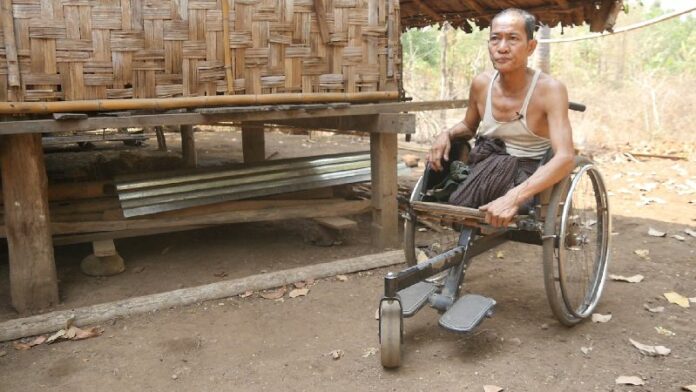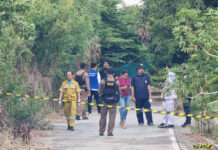
KYAUKKYI, Myanmar — Two years ago, Kyar Yin was in the forest near his village collecting bamboo to sell when he stepped on a landmine.
Alone and his left leg badly injured, the 56-year-old farmer was forced to take drastic action.
“I sat up and pulled out my knife and started to cut my leg away myself,” he said. “It hurt so much, but I kept cutting the meat from my leg and throwing it away.
“I had no choice but to cut my leg by myself because if I didn’t, it would get worse.”
Aung Chan Thar, Kyar Yin’s village in Kyaukkyi township in eastern Myanmar’s Kayin State, was once the frontline in a bitter conflict, once dubbed the world’s longest-running civil war, between the Karen National Union (KNU) and the Myanmar military.
As is common in Myanmar’s ethnic conflicts, land mines were a weapon of choice for both sides and the jungle around Aung Chan Thar is littered with them.
But the forest also provides the villagers, many of whom survive on subsistence farming and trading in products from the rainforest, with everything – from wood and leaves for their homes to betel nuts and bamboo to sell at the market.
Every time the villagers enter the forest, they are conscious that their lives are at risk, a situation faced by millions of villagers in Myanmar’s conflict-scarred ethnic borderlands.
Across Myanmar, hundreds fall victim to this hidden weapon every year. According to Landmine Monitor, Myanmar is the third worst country in the world for annual landmine casualties. There were at least 3,745 reported casualties between 1999 and the end of 2014, though it is thought the real figure could be much higher.
Today, Kyar Yin envisages a different use for his knife.
“If I met the people who made me like this, I would want to kill them with my own knife,” he said, leaning against a tree to take the weight off his wooden prosthetic leg.
Five Legs Between Six People
Kyar Yin is not alone in having been maimed by landmines: six members of his family, including himself, have also been injured. They have five legs between them.
Kyar Yin’s brother Kyar Khin was in the jungle with his wife collecting bamboo when he stepped on a mine. He lost both his legs.
“I remember it was raining, and there was a lot of blood,” he says. “My wife put me on my side and covered my lower half with a blanket.”
Men are most commonly the victims of landmines around Aung Chan Thar because they are normally the ones working in the forest. Kyar Khin, a father of four, now struggles to provide for his family.
“My wife is finding money at the moment,” he says. “She collects leaves and she sells those. It is not enough… Sometimes, I make bamboo baskets. I can earn 500 Kyats (15 baht) a day. With the leftover money, I buy my medicine.”
Kyar Khin’s cousin Ngwe Yin was the village’s first land mine victim 40 years ago.
Standing in the bamboo field where she lost her right leg, she points to the spot where she was injured and recalls how when her mother and aunt came to help her, they too stood on land mines.
“My aunt lost both of her legs, and my mother had severe injuries to her abdomen and face,” she says.
Since her injury, she says 20 people have been killed and 12 more disabled by landmines in the village of 700 people.
Fuelled By Conflict
Kyar Yin, Kyar Khin and Ngwe Yin all blame the Karen National Union for the landmines that injured them. They accuse the KNU of not just laying landmines in the conflict with the Tatmadaw, Myanmar’s army, but also to protect teak trees that they did not want villagers to cut down, and as a punishment for not paying taxes.
A KNU spokesman said both the KNU and the Tatmadaw had laid land mines in the area. However, he denied the group had used mines to protect trees or as a punishment against villagers.
Myanmar’s ethnic armed conflicts are at the heart of the landmine issue, and much hope rests on getting all ethnic armed groups to sign up to the Nationwide Ceasefire Agreement.
“If all the stakeholders are signing the ceasefire agreement then the landmine issue will be automatically included,” National League for Democracy patron Tin Oo told Myanmar Now.
“We are very hopeful during this government this land mine issue will be sorted out.”
When Will They Be Cleared?
International NGOs are ready to start the process of clearing land mines, but to date not a single landmine has been officially removed.
Ingeborg Moa, acting country director for Norwegian People’s Aid, said before Myanmar began its democratic transition in 2011, you could not even use the phrase “landmine” when talking to government officials.
“We would rather talk about ‘threats to life and health’ as a sort of code-word for these hazards,” she says.
“This has completely changed, and both the authorities and the different ethnic armed organisations are now willing to discuss landmines and mine-clearance issues openly with us.”
Norwegian People’s Aid has carried out broad surveys to try and gather information on where land mines may be located, but has not been given the green light to carry out the technical surveys that would specifically locate the devices.
Moa says the progress already made in achieving peace – eight armed groups signed the NCA in October last year – is enough to start landmine clearance procedures.
Life-Long Impact
For the villagers in Kyaukkyi township, the sooner something happens the better. They say land mines do not just cause physical loss, but also lasting psychological damage.
In Kawt Byinn village, Ngwe Yee, 31, provides counselling to disabled people. She was 21 when, in November 2004, she was taking food to her parents in the forest and her bicycle hit a landmine. She lost her right leg.
She says: “Most people (with land mine disabilities) just stay at home; they don’t normally go out and work because they are depressed. A lot of the men become alcoholics.
“So I say to the girls: ‘Let’s go out sometimes, this is not shameful. We can go out together and we can be involved in social activities’.”
Ngwe Yee is putting on a brave face. The mine not only shattered her leg but also her dreams of running her own shop.
“Now I have no dream anymore, because I can’t do it,” she said, sitting outside her parents’ home, with tears welling in her eyes.
“Though I am not feeling very good myself, I cannot show this to other disabled people because I am supposed to help them. I need to stay strong in front of them.”
Story: David Doyle
Related stories:











































